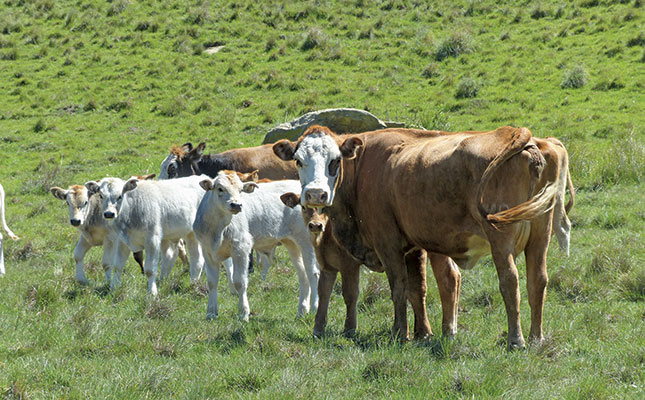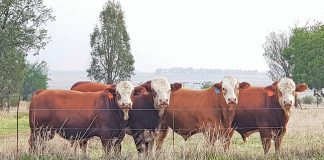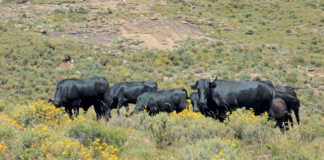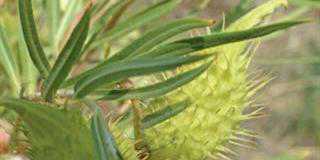
Photo: Mike Burgess
The first Romagnolas were imported to South Africa in 1995 by Italian businessman Armando Balocco, who established a stud on the farm Rosengarten near Hekpoort in North West.
Balocco originally imported a bull, a cow with calf at foot, and two heifers. Before the end of the year, he augmented these with six more heifers.
The fledgling Rosengarten stud was then developed in virulent redwater, heartwater and gallsickness veld via an artificial insemination and embryo transfer programme.
Neville Bradfield managed this pioneering Romagnola stud from 2003 to 2009. It became the source from which other South African breeders, including Bradfield himself, would procure their foundation genetics.
“It was amazing at Rosengarten,” he recalls. “It’s incredible to be involved in breeding large animals that are in such balance.”
Bradfield registered his two-cow Argyros Romagnola Stud on Rosengarten in 2006. Three years later, he took the animals with him when he returned to the 2 500ha family farm near Dordrecht in the Eastern Cape, Mount Hope, where his father still lived.
Today he has 90 registered Romagnola females that produce exceptional bulls, including the Agricultural Research Council (ARC) National Special Performance Test Bull winner for the Romagnola breed for 2018.
From Italy to Africa
Bradfield is passionate about the Romagnola and its history, and in 2005 attended the Romagnola World Conference in Italy. The breed can be traced back to the 4th century AD, when the Goths introduced its predecessors to Italy.
These cattle became synonymous with the fertile Romagna, a region in Northeast Italy, and by the 20th century were divided into three subgroups that were sought after as draught animals.
This changed during the second half of the 20th century as increased mechanisation steered selection towards beef and carcass characteristics.
Formally initiated by the National Association of Italian Beef Cattle Breeders, this selection was underpinned by performance testing that measured growth, muscle development and carcass yield. Females were selected predominantly for reproductive efficiency and maternal capacity.
Today, the Romagnola’s value in crossbreeding programmes has taken them across the world.According to the outgoing president of the South African Romagnola Cattle Breeders’ Society, Willem Wagenaar, who farms Romagnola in the Eastern Cape, South Africa is currently home to 1 320 registered animals (977 females and 343 bulls).
Romagnola genetics have also made their way to Namibia, Botswana, Zambia and Uganda.
Establishing the stud
Bradfield’s first two cows were given to him by Balocco in 2006 for the exceptional service he had rendered on Rosengarten.
In time, these were augmented by genetics from other breeders, including Arthur Cockcroft, who imported 12 heifers from Italy in 1996, Francois Coertzen of Vanderbijlpark, and Dail van Rensburg of Delareyville in North West.
Bradfield arrived on Mount Hope in 2009 with eight Argyros stud cows and a bull. With mature Romagnola cows weighing between 660kg and 700kg each, he was initially concerned about their ability to manage the extensive conditions of the Stormberg.
However, they adapted to the region with ease, and Bradfield was especially impressed by their ability to negotiate the mountains of the area.
“Their legs are longer than other cattle’s, so they can actually walk up where the wethers go,” he says.
Today, Bradfield’s Romagnolas are completely at home in the Stormberg, a harsh region that sees temperatures drop to -18°C in winter. Although estimated breeding values are critical in the selection programme, Bradfield stresses that cattle need to be first and foremost functionally efficient within the natural environment.
“Good old stockmanship is vital. You have to see if the animal can walk and if it’s functionally efficient before considering figures,” he says.
Although run predominantly on veld, the cattle, along with the crossbred commercial herd, are supported by Eragrostis bales produced on about 60ha of dryland.
All cattle receive a protein/salt lick in winter and a phosphate/salt lick in summer.
They are subjected to a standard inoculation and dosing programme and receive a pour-on dip twice a year for tick and lice control.
Breeding
Mating season for the stud is from November to January, and females are flushed simply by ensuring good grazing before mating.
All cows are mated in single-sire herds, but replacement heifers (about 20) are artificially inseminated with semen from Italy and Australia. Bradfield is also investigating possibly importing semen from the US and Canada.
The stud’s conception rate is always above 90%, fertility that is well reflected in an average herd intercalving period (ICP) of 380 days. (The best individual animal has an ICP of 346.)
Bull calves in the stud have a weaning weight of between 290kg and 330kg, while heifers wean at 220kg to 290kg.
Herd sires are either self-bred or, more recently, purchased from Van Rensburg. Three stud bulls undergo Phase C performance- testing in Alexandria each year. A total of 15 bulls are sold from Mount Hope and at the Cedarville Multi-breed Bull Sale in KwaZulu-Natal, with prices ranging from R40 000 to R50 000 each.
Although few females are sold, prices are handsome; in 2008, for example, a heifer fetched R20 000.
Bradfield says that due to import restrictions on live animals due to mad cow disease as well as the Italians’ unwillingness to share semen, he plans to import embryos to obtain new genetics.
Commercial crossbreeding
Bradfield’s 2018 Romagnola ARC National Special Performance Test Class bull represents the value a Romagnola bull can add to a commercial crossbreeding programme.
Argyros NB 16 04 was born on 12 September 2016 weighing 40kg. Its dam has an ICP of 366 days over six calves, an average daily gain score of 2,146 and a feed conversion ratio score of 6,02.
The genetics of Argyros NB 16 04 will clearly offer value to any weaner production programme, especially by introducing hybrid vigour in a crossbreeding programme.
Bradfield had carefully considered a number of factors before returning to the Stormberg with his Romagnolas.
“I thought I could diversify with a stud,” he says. “It was an economical consideration to bring Romagnolas to Mount Hope and to use them in a commercial beef operation.”
Today, Romagnola bulls play a crucial role in Bradfield’s three-way crossbreeding programme, which involves about 150 Angus- and Hereford-type cows. All commercial heifers, however, receive Hereford and Angus bulls, and Bradfield says he has minimal to no calving issues amongst his Romagnola cows.
“Farmers can keep their existing herd and put a Romagnola bull to them, and be assured of top weaners,” he says.
In this regard, one of the best endorsements of the breed is the fact that Bradfield has regular clients from the Sterkspruit region of the former Transkei.
The region, he says, is probably one of the toughest communal environments to farm in South Africa, tolerating only the hardiest of genetics in crossbreeding programmes.
Email Neville Bradfield at [email protected].











